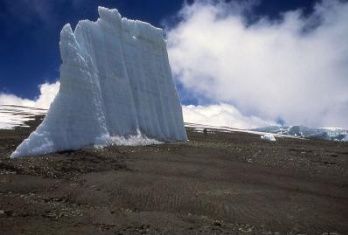Goodbye, snows of Kilimanjaro
By Jeremy Hance, www.mongabay.com, November 02, 2009 The most recent survey among the ice fields atop Mount Kilimanjaro found that the ice atop Africa’s most famous mountain could be gone in twenty years—and maybe even sooner. Published in the Proceedings of the National Academy of Science the study [pdf] was conducted by a team of researchers who first measured the glaciers in 2000. They discovered that between 1912 and 2007, 85 percent of the ice that covered Mount Kilimanjaro vanished. When using 2000 as baseline the mountain has lost 26 percent of its ice. These findings are unique in the last 11,700 years: an ice core going back nearly twelve millennia found no evidence of sustained melting until contemporary times. Even a 300-year-long drought 4,200 years ago, which left Mount Kilimanjaro blanketed in 1-inch thick dust, did not lead to any melting. Perhaps most surprising was the discovery that the loss of ice by thinning is now almost equal to the loss of ice by shrinking. “This is the first time researchers have calculated the volume of ice lost from the mountain’s ice fields,” said Paleoclimatologist Lonnie Thompson, a research scientist with Ohio State’s Byrd Polar Research Center. “If you look at the percentage of volume lost since 2000 versus the percentage of area lost as the ice fields shrink, the numbers are very close.” Furtwängler Glacier atop the mountain has melted 50 percent from 2000 to 2009. “It has lost half of its thickness,” Thompson explained. “In the future, there will be a year when Furtwängler is present and by the next year, it will have disappeared . The whole thing will be gone!” …
